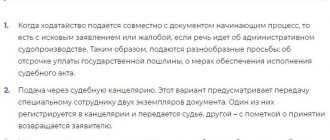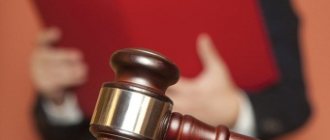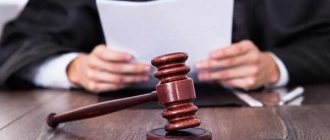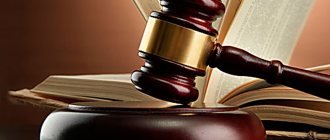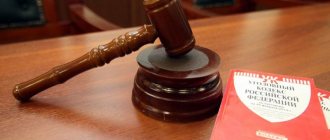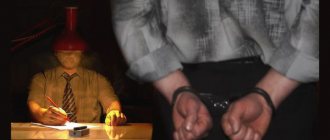The general procedure for preparing for a court hearing in criminal proceedings is a separate stage of the process preceding the consideration of the case on the merits.
Regulatory regulation – Chapter 33 of the Code of Criminal Procedure. Current legislation instructs judges to accept cases in accordance with the forms specified in the law governing the criminal process. The case materials are sent to the court after completion of preliminary assistance and are located directly with the judge for analysis and analysis. Multi-channel free hotline Legal advice on criminal law. Every day from 9.00 to 21.00
Moscow and region: +7 (495) 662-44-36
St. Petersburg: +7 (812) 449-43-40
Essence and goals of training
This stage is the preparatory part of the court hearing in criminal proceedings, separating the investigation and the trial itself - the central blocks of the process.
The court does not automatically have an obligation to consider all received cases. He determines the grounds for further pursuing the case. The exclusive prerogative of the court is to send materials for trial (if there are no obstacles).
Preparation for the hearing is an intermediate link between the work done by investigators and interrogators, and the work of the judge.
This is where control takes place to determine the readiness of materials. If violations (procedural, formal) are identified, the materials are sent for revision and correction. An analysis is carried out to ensure that the materials are fully compliant.
The judge's task should be to decide:
- send materials according to jurisdiction;
- schedule a preliminary meeting;
- set a trial date for the case.
The importance of correctly determining jurisdiction is to respect the constitutional right of the accused to have the case considered by a lawful panel in a particular court.
The purpose of the preparatory phase is determined by the answer to the main question: “are there sufficient factual and legal grounds for the trial?”
How can a lawyer prepare for a court hearing?
What do we consider a complex case where this approach has been tested repeatedly? First of all, these are disputes with a large amount of information: tax, protection from bringing owners and top managers to subsidiary liability in bankruptcy, exclusion of a participant from the company, collection within the framework of a construction contract, etc.
Methods for systematizing material help to reduce multi-level argumentation into tabular forms. For example:
| Opponent's argument | Counterargument | Legal basis | List of supporting evidence | Link to case materials |
And if you challenge the decision of the tax authority, the table could look like this:
| Argument of the tax authority | Quote from the interrogation (available in the contested decision) | Interpretation of the quote as a counter-argument | Quote from the interrogation (not in the decision, but in the audit materials) | Link to case materials |
The case through the eyes of a judge
All lawyers know that a thorough knowledge of the case materials allows them to convincingly convey their position to the court. You can increase the level of such persuasiveness if, when preparing for a case, you have before your eyes not only all the documents laid out according to the system familiar to lawyers (procedural documents of the plaintiff, defendant, evidence in the case, judicial acts, etc.), but also materials cases as they appear in court.
To test the strength of both sides' arguments, you need to look at the case through the eyes of a judge.
In addition, sometimes during preparation it turns out that some evidence has not yet made it into the case file, although there is already a link to it in the explanations, because this document is already in your folder! And it is especially useful to have a copy of the court case file with you during the trial: you never know what question the court may have, so being able to instantly find the right case sheet to support your argument can sometimes decide the outcome of the case.
In the appellate instance of the arbitration court, we sought to have the decision to recover 56 million rubles from the principal overturned. (a complex subject of dispute is damages from a construction contract). During the debate, the opponent mentions a prejudicial circumstance, which is allegedly contained in the decision of the court of general jurisdiction, included in the materials. If all 36 volumes of the case had not been with us on appeal, we would not have been able to clearly refute the “attack”, since the argument was not stated in the first instance court and was absent in the response to the appeal. A multi-page inventory of all court materials, colored with the numbers of the arguments of both sides, would not have saved us, since only reading a specific document and promptly pointing the court to the required sheet of the case file of a 25-page decision of a court of general jurisdiction revealed the artificiality of the reference to prejudice and restored the balance of trust in what our team was putting forward positions.
Legal processing of all arguments
When filing a claim, the biggest risks are errors in choosing the subject and basis. Legal examination of all arguments both in favor and against the protected material interest of the principal allows us to correctly determine the controversial legal relationship, the circle of persons and the applicable norms.
Particularly difficult to protect the interests of the principal are cases that are filed after a loss in the first instance. The entire evidence base has been formed; it is almost impossible to overcome the restrictions on its addition. In such cases, the role of persuasiveness of the complaint is extremely high, and therefore its arguments are presented in the most favorable hierarchical order: first strong, then medium, and at the end the strongest. The text of the complaint is reduced as much as possible by transferring into appendices arguments that require a detailed theoretical digression, or extensive mathematical calculations, or tabular systematization of evidence, judicial practice. A thesis statement of the grounds for the reversal of judicial acts allows you to correctly place emphasis without distracting attention to the details (unless these are circumstances for unconditional reversal).
Correct judicial tactics
Developing judicial tactics is a key stage in preparing for the trial. The order of submission of petitions and arguments in favor of our position is determined. We show caution - we are not in a hurry to substantiate a circumstance that has not yet been disputed by our opponent.
The “excellent student syndrome” can work to the benefit of the other party, who has not yet realized the possibility of challenging a specific fact.
But we formulate the arguments that we are ready to bring in defense of our position, which has not yet been challenged, in the form of a separate document (“explanations of the party on the issue of...”), which we take with us into the process. This brings a double benefit: it does not allow opponents to cast doubt on the stability of the position you are defending and at the same time increases the court’s credibility in the professionalism of the representative.
Preparing for possible actions of opponents
It is also helpful to distribute arguments judiciously between stages of the legal process. For example, there are arguments that are useful to leave to those stages in which opponents cannot supplement the case with new evidence. During the consideration of the case for the recovery of damages related to the loss of the aircraft, we noticed that the defendant, disputing the amount of damages, refers to the assessment made on the date of the death of the aircraft, and not on the date we filed the claim. We did not refer to this circumstance during the judicial investigation until the stage of argument, understanding that the party at this stage did not have the opportunity to introduce new evidence. The improper assessment date resulted in the opponents’ lack of admissible evidence, which influenced the court’s decision in favor of our client.
In another case, the opponent, objecting to the signature belonging to an employee of the organization, did not declare an examination or other method of verifying its authenticity. It would be possible to point out this to be convincing during the consideration of the case, but this would allow the opposite party to delay the consideration of the case for the duration of the examination, which was contrary to the interests of our client.
Analysis of decisions of a specific judge
We also try to take into account that decisions are made not by an abstract court, but by a specific person, including taking into account his inner conviction. Therefore, for complex categories of cases, especially with a low percentage of satisfaction, it is important to analyze what “inner conviction” a particular judge came to in this category of cases.
Analyze judicial practice and make a list of arguments that are perceived positively by this judge or, conversely, are rejected due to their unconvincingness for him.
This approach allows you to correctly distribute efforts to argue a position, as well as understand what circumstances require additional efforts to prove and justify. Sometimes this approach allows you to find a way out of a difficult situation.
In one case, we defended a client in respect of whom the antimonopoly authority issued a decision to bring him to administrative liability in connection with violation of the deadline for concluding a government contract. The situation was caused by the negligence of the employee who was responsible for the organization’s participation in government procurement: after another participant won the auction, this employee stopped tracking them. Therefore, he did not notice that the winner dropped out of the participants without concluding a government contract, after which the responsibility to conclude it passed to our principal. The formality of the offense did not allow the OFAS decision to be canceled as illegal, and the principal faced the threat of losing the right to participate in public procurement for two years with an estimated loss of revenue of 800 million rubles. An analysis of the decisions of a particular judge helped us find a compromise solution: we recognized the company’s guilt in a specific offense, but achieved the reversal of the decision of the Federal Antimonopoly Service regarding the inclusion of the principal in the list of unscrupulous suppliers. The basis for the partial cancellation was the conscientious actions of our principal to compensate for losses to the government customer (he was compensated for the difference in the price of products supplied by another bidder).
Opponents' ideas
We also have a rule: we collect not only our successes, but also the successful finds of our opponents into our arsenal. This is how you can overcome an individual defeat and win the “war.”
- Pravo.ru
- Arbitration process
- Civil process
General procedure
The judge examines and studies the received materials, checks how the law on pre-trial proceedings was observed, and identifies the existing grounds for considering the case on the merits. The above scheme applies if there is no need to schedule a preliminary hearing.
This procedure is a simple form, where the judge, as the direct subject of judicial legal relations, decides for himself how the process will proceed (without calling the parties). The case is assigned to a specific judge. This is a one-man job. If there are no obstacles to transferring the case to trial, the judge makes a decision. This completes the preparatory part. Its implementation is evidenced by the issued decision.
The judge acts as a guarantor that no citizen will appear in court without proper grounds. You need to make sure that the accusation was brought forward legally and that the formalities of proper paperwork are met. It is forbidden to proceed with a case with violations of the law (absence of a lawyer, expiration of the statute of limitations, re-filing).
Events
The judge is obliged to determine whether there are petitions or complaints that must be resolved
It is important that only justified requests are granted. The judge, at the request of the parties, may provide them with the materials of the case for review.
The reasons for refusal are indicated in the decision.
The range of measures taken to compensate for the damage includes the forced confiscation of everything that was obtained during the commission of the offense. It is possible to seize the property of the accused and other persons if it is possible to believe that such valuables were received during the commission of an offense.
Upon receipt of requests for a preliminary meeting:
- legitimate reasons are determined;
- requests are either granted or denied;
- If such requests are not granted, then a hearing date is set.
Considering the circle of persons whom the parties have submitted to the summons, the judge has the right to identify other citizens.
If a violation is identified in the procedural documents, for legitimate reasons, it is decided to return the case to the referring authority. The discrepancy between the charges brought in the procedural documents, the lack of signatures, approvals, and approvals is a clear violation.
If violations are detected, the materials are returned for correction, and a judge’s decision is made.
Features of document analysis in the case
The totality of all main and supporting documents constitutes the case materials. Such documents record and consolidate actions and legal relations in criminal proceedings. In order for the case to be admitted for consideration, a complete analysis of the documentation contained is necessary.
Main documents of the court case:
- regulations;
- protocols;
- indictments (acts).
They are accepted for key events of the investigation and are required to be drawn up.
Their form is regulated by law. Resolutions are adopted when they want to record particularly significant actions. The protocols record the progress of the investigation. Results: protocols of testimony, inspection. Verification of the correctness and validity of the indictment requires close attention. This is the basis of the principle of sufficient grounds for a person to appear before justice. It is necessary to properly analyze these procedural documents.
There are also auxiliary documents drawn up depending on the circumstances of the case, the identity of the accused, the victim and others (explanations, statements, subscriptions, obligations).
When studying the collected documentation, it is necessary to evaluate it from the point of view of procedural and substantive law. A formal and normative verification method is used. Formal includes external inspection and analysis of the document for the presence of all mandatory details, regulatory – for compliance with current legislation.
In this sequence, using both formal and normative methods, the materials of the criminal case are studied. The quality of the investigation depends on the correct preparation of documents.
Any error, both formal and normative, can be an obstacle to further prosecution of the case.

